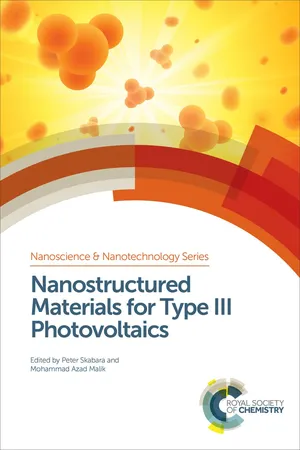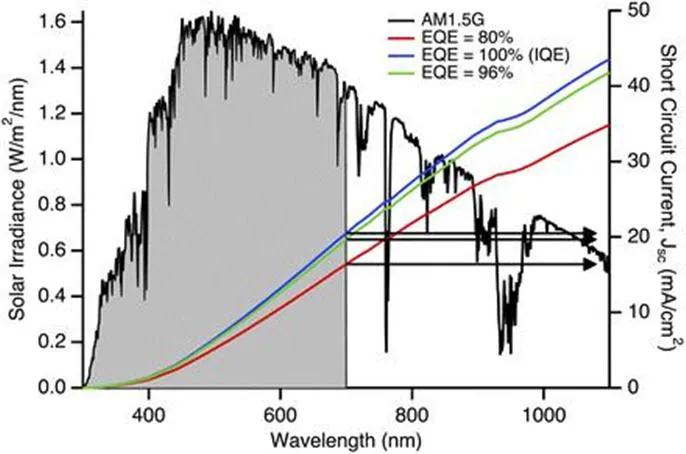MATTHEW O. REESE, ASHLEY R. MARSHALL AND GARRY RUMBLES*
1.1 Introduction
The most reliable method of determining the power conversion efficiency (PCE) of a new solar cell is to send it to an accredited testing laboratory, such as the National Renewable Energy Laboratory (NREL), the Fraunhofer Institute for Solar Energy Systems or the National Institute of Advanced Industrial Science and Technology. However, this is not always a practical solution and these certification laboratories only determine the efficiencies of solar cells that have already been tested in a researcher’s own laboratory and have shown a promisingly high performance. The record efficiency “hero” cells, certified in accredited laboratories, have been tracked and the results have been published semi-annually in Progress in Photovoltaics: Research and Applications2 since 1993.3 A graphical depiction of these published hero cell performances, and earlier data, is recorded on a chart, the May 2017 version of which is shown in Figure 1.1. The most recent version of this graph can be found online,1 including an interactive version.4
Figure 1.1 Research cell efficiencies from 1976 to 22 May 2017.1 Certified photovoltaic data reported primarily from the National Renewable Energy Laboratory (NREL), the Fraunhofer Institute for Solar Energy Systems (FhG-ISE) and the National Institute of Advanced Industrial Science and Technology (AIST).
The solar cell systems described in this book fall into the category of emerging photovoltaics and include dye-sensitized solar cells (DSSCs), organic photovoltaic (OPV) cells, quantum dots, perovskite solar cells (PSCs) and the new copper zinc tin sulfide inorganic cells. Although these new photovoltaic technology platforms are identified on both the NREL and IEEE charts, the values are tabulated in Progress in Photovoltaics: Research and Applications2 and on charts as “notable exceptions” because they rarely comply with the full set of stringent tests associated with the certification process. Specifically, the active areas measured for these emerging devices are often less than the required 1 cm2 and issues associated with device stability during the evaluation process might also be questionable. Regardless, the values cited serve as a valuable target for researchers aiming to improve device performance. The recognition of a researcher’s efforts on the chart is a frequent goal of many in the field of solar photovoltaics.
Small devices are commonly made in the world of emerging photovoltaics for several reasons. Small devices are often constructed on a single larger substrate yielding, for example, six or eight discrete pixel-type solar cells that can be constructed from the same set of depositions, thus providing a good range of performance statistics. The amount of active material available is often restricted or expensive and smaller devices reduce the amount of material required to evaluate the performance of the solar cell. A small device also provides an opportunity to reduce the impact of the sheet resistance on the fill factor. Within the ranks of hero cells for emerging photovoltaics, most devices have active areas, apertured or masked, of ∼0.05 cm2, with only the current record DSSCs exceeding the required 1 cm.2 For example, the current record for PSCs as a “notable exception” is 22.1%, whereas at 1 cm2 the PSC record is lower at 19.7%.2
Why is it important to precisely determine the PCE of a new cell? The primary reason is to ensure that a researcher can identify advances in their own work so that new findings are discovered and can be exploited. It is also necessary for different research groups to be able to repeat published research and obtain similar results. To demonstrate and report a record efficiency, it is necessary to have the device certified by a recognized center. Making a good, reliable efficiency measurement helps to pre-screen devices that are suitable for the certification process, although this can be both costly and time consuming. For systems that have the potential to be scaled up to larger device areas or modules, it is important to know that the starting point is good.
Despite repeated efforts to caution the photovoltaic community of the need to make good device performance measurements and descriptions of the exact methods required to avoid mistakes, erroneous reporting still occurs.5–9 Some journals have attempted to introduce itemized checklists to prevent this,10 but it is easy to make the wrong measurements and to inadvertently publish incorrect results. A common method used by researchers at NREL when reading or reviewing a new article is to determine the short circuit current, Jsc, predicted from the external quantum efficiency (EQE) data in the article and to compare this with the measured Jsc values under one sun illumination. The latter are occasionally observed to be far higher due to poor device stability or errors in determining the active device area.11 These data are often shown to have Jsc values that exceed the Shockley–Queisser limit.12 Figure 1.2 plots the AM1.5 spectrum with three scenarios of short circuit current versus the optical bandgap: (1) EQE = 100%, corresponding to the optimum internal quantum efficiency; (2) EQE = 96%, corresponding to a reflectivity of ∼4% from the device surface; and (3) EQE = 80%, corresponding to a reasonably good device. A device with an optical bandgap of 700 nm (1.77 eV), as depicted in Figure 1.2, would have maximum short circuit currents under these three situations of 20.5, 19.6 and 16.4 mA cm−2, respectively.
Figure 1.2 Shockley–Queisser current limits. Plots of maximum integrated short circuit current (Jsc) as a function of the optical bandgap for ideal EQE scenarios: 100% (blue); 96% (green); and 80% (red). The three arrows show the maximum current associated with a system with an optical bandgap at 700 nm.
Although the device performance group at NREL is accredited by the American Association for Laboratory Accreditation to ISO-17025 standards, it was necessary to develop additional capabilities to rapidly evaluate the performance of the many new emerging photovoltaic solar cells being constructed prior to identifying hero devices suitable for certification, despite the fact that these hero devices are often certified at one of the other two accredited laboratories. This additional capability is described here, together with the rationale for its design and the protocol used to measure many different types of cells with the goal of obtaining reliable data accurate to ∼95%.
To make a good measurement of solar cell efficiency for high-quality science requires the acquisition of the following:
- a well-measured spectrum of the lamp used in the solar simulator;
- a determination of the spectral mismatch factor between the lamp spectrum, the test cell and the reference cell;
- a measurement of the illuminated device area;
- an EQE spectrum of the cell under test; and
- measurements made with care.
1.1.1 Lamp Spectrum
In establishing a new set-up to make efficiency measurements, the most central piece of equipment is generally viewed to be the solar simulator, which can easily cost many tens of thousands of dollars; however, with more care this might not be necessary. When considering a new purchase, and sometimes evaluating others’ work, many researchers focus on the class of the simulator as designated by the International Electrotechnical Commission (IEC) standard 60904-9 (there are also country-specific standards such as the American Society for Testing and Materials (ASTM) E 927-05 and the Japanese Industrial Standard (JIS) C 8912). As the class system is intended to designate how easy it will be to make a good measurement, this is not unreasonable. Using an AAA simulator does not guarantee good results, however, just as using a less well-matched sim...


